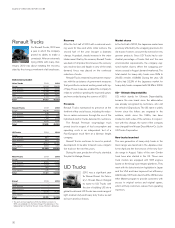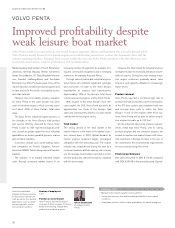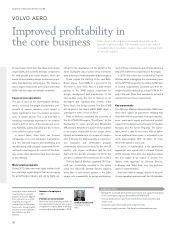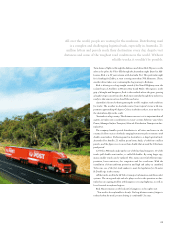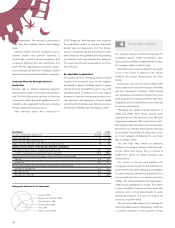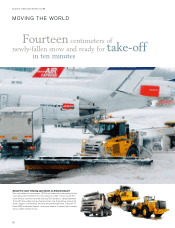Volvo 2010 Annual Report Download - page 44
Download and view the complete annual report
Please find page 44 of the 2010 Volvo annual report below. You can navigate through the pages in the report by either clicking on the pages listed below, or by using the keyword search tool below to find specific information within the annual report.
Conducts operations in cus-
tomer and dealer financing.
Martin Weissburg
President of Volvo
Financial Services.
Number of employees
1,235
Position on world market
Volvo Financial Services operates
exclusively to support the sales and
leasing of vehicles and machines
which are produced by the other
Business Areas, enhancing their
competitiveness.
Ambitions 2010
• Support customer and dealer downturn activities while mitigating the
frequency and severity of credit losses.
• Adapt commercial strategy to lessons learned from the downturn to achieve
sustainable profitability.
• Operational improvement and efficiency.
• Secure diversification of funding channels in cooperation with Volvo
Treasury.
Stabilization of portfolio
As the world began to emerge from the global
economic and financial crisis, 2010 was a year of
stabilization for VFS. While the first half of the
year continued to be plagued by a challenging
economic environment, the second half began to
demonstrate more positive trends, characterized
by a reduction in overall levels of customer delin-
quencies, inventories of repossessed vehicles
and default activity.
Throughout this period, VFS executed on
enhanced portfolio management and collection
techniques while strengthening and standardiz-
ing its operations. As VFS stabilized its portfolio,
it did so in close alignment with the other Volvo
Group business areas and distributors, with a
focus on building and maintaining customer rela-
tionships.
Market development
VFS is a stronger and more agile organization
today than before the downturn and is well posi-
tioned for growth. Continuing to develop scalable
and efficient business platforms will provide the
capacity for VFS to grow its global portfolio.
In mature markets such as North America and
Europe, operational leverage is essential to future
development. In Asia Pacific, VFS is making fur-
ther investment in support of prudent growth. The
development of the BRIC markets remains in
focus while maintaining stable and standardized
operations and systems.
Developing integrated offers with the other
Volvo Group business areas will also continue, as
VFS supports the Volvo Group in developing
sales opportunities and building close customer
relationships.
Financial performance
Total new financing volume in 2010 amounted to
SEK 35 billion (29). Adjusted for changes in
exchange rates, new business volume increased
by 26% compared to 2009 as a result of
increased sales volumes of the Volvo Group prod-
ucts and good penetration levels. In total, 34,522
new vehicles and machines (25,782) were
financed during the year. In the markets where
financing is offered, the average penetration rate
was 25% (25).
At December 31, 2010 total assets amounted
to SEK 89 billion (99). During 2010 the credit
portfolio decreased by 4.4% (decrease: 15.6),
adjusted for exchange-rate movements, to gross
credit portfolio SEK 84,550 M (94,988). The
funding of the credit portfolio is matched in terms
of maturity, interest rates and currencies in
accordance with Volvo Group policy. For further
information, see note 36.
The operating income for the year amounted to
SEK 167 M compared to operating loss of SEK
680 M in the previous year. Return on sharehold-
ers’ equity was 0.4% (neg: 6.2). The equity ratio
at the end of the year was 9.0% (8.7). The
income is driven mainly by lower credit provisions.
During the year, credit provision expenses
amounted to SEK 1,438 M (2,327), while write-
offs of SEK 1,460 M (2,223) were recorded. The
write-off ratio for 2010 was 1.65% (2.09). At
December 31, 2010, credit reserves were 1.69%
(1.67%) of the credit portfolio.
As a consequence of the strong volume growth
in Brazil, it was decided to syndicate approxi-
mately SEK 4 billion of the Brazilian credit port-
folio as a risk mitigation measure and to free up
capital for reinvestment in the country. The trans-
action generated a positive impact on operating
income of SEK 38 M.
In May, VFS successfully completed its first
asset-backed securitization in many years. Under
the terms of the transaction, USD 616 M of secu-
rities tied to U.S.-based loans on trucking and
construction equipment assets were issued.
VOLVO FINANCIAL SERVICES
Positioned for growth
Volvo Financial Services (VFS) supports the Volvo Group product
range with integrated financing solutions to help customers
acquire the products they need to build their business.
BOARD OF DIRECTORS’ REPORT 2010
40


